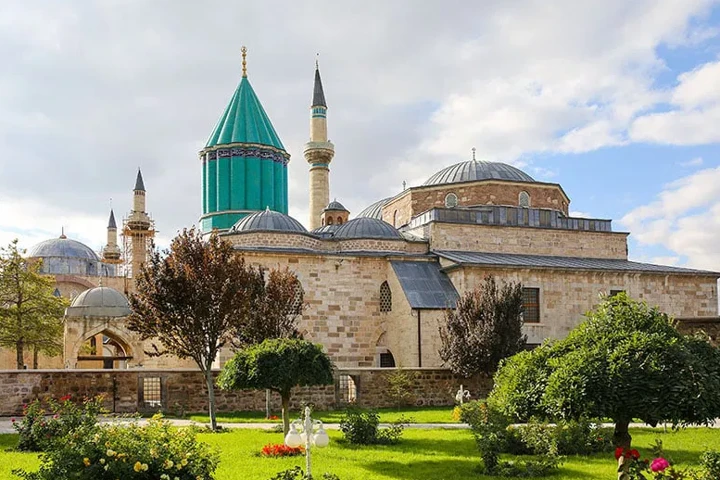- Home
- Flight Ticket
- Konya Flight Ticket
Konya
Konya City Guide

Welcome to Konya, a city that resonates with deep spiritual significance and a rich historical tapestry, located on the vast plains of Central Anatolia.
Konya is renowned worldwide as the final resting place of Mevlana Celaleddin Rumi, the 13th-century Sufi mystic, poet, and theologian whose teachings of love and tolerance have inspired millions. Beyond its profound connection to Rumi and the Mevlevi Order (Whirling Dervishes), Konya boasts a heritage as one of Turkey's oldest continuously inhabited cities and served as the illustrious capital of the Seljuk Sultanate of Rum. This legacy is beautifully preserved in its stunning mosques, medreses, and caravanserais.
Discover the Spiritual Heart of Anatolia: Your Essential Guide to Konya
Prepare for a journey that touches both the mind and the soul.
Getting to Konya: Flights
Konya is served by Konya Airport (KYA), a civil-military airport located northeast of the city center. It handles regular domestic flights from Istanbul and other major Turkish cities, along with some international connections.
Where to Stay: Your Accommodation in Konya
Konya offers a variety of hotels, generally concentrated in the city center, providing convenient access to the main historical and spiritual sites.
- Near Mevlana Museum: Many hotels are situated within walking distance of the Mevlana Museum, catering to pilgrims and tourists alike.
- City Center: You'll find a range of modern hotels offering various amenities in the broader city center area.
Must-See Attractions & Things to Do in Konya
Konya is a city rich in sites of spiritual and historical importance.
- Mevlana Museum (Mevlana Müzesi): This is the absolute heart of Konya and a major pilgrimage site. The complex houses the mausoleum of Mevlana Celaleddin Rumi, as well as a museum displaying artifacts related to his life, the Mevlevi Order, and Seljuk-era art. The distinctive green-tiled dome is an iconic symbol.
- Alaeddin Hill (Alaeddin Tepesi) & Alaeddin Mosque (Alaeddin Camii): This man-made hill in the city center is topped by the historic Alaeddin Mosque, one of the oldest Seljuk mosques in Turkey, dating back to the 12th century. The hill also offers pleasant park areas.
- Karatay Medrese (Tile Museum): A beautifully restored Seljuk-era theological school, now a museum showcasing exquisite Seljuk tiles and ceramics. Its dome is particularly impressive.
- İnce Minare Medrese (Museum of Stone and Wooden Works): Another stunning example of Seljuk architecture, famous for its ornate portal and minaret (though the top of the minaret is missing). It now houses a museum of stone and wood carvings.
- Selimiye Mosque (Selimiye Camii): Located adjacent to the Mevlana Museum, this grand Ottoman-era mosque was commissioned by Sultan Selim II and designed by Mimar Sinan (or his school).
- Konya Archaeological Museum: Displays artifacts from the region spanning from the Neolithic era to the Ottoman period, including finds from Çatalhöyük.
- Çatalhöyük (Neolithic Site): A UNESCO World Heritage site located about an hour's drive from Konya, Çatalhöyük is one of the oldest and most significant Neolithic settlements ever discovered, offering a fascinating glimpse into early human urban life (circa 7500 BC).
- Sille Village: A charming historic village just outside Konya, once home to a significant Greek Orthodox community. It features rock-cut chapels (like Aya Elena Church) and traditional stone houses.
- Sema Ceremony (Whirling Dervishes): Witnessing an authentic Sema ceremony, the mystical whirling dance of the Mevlevi Order, can be a profound experience. Check the Mevlana Cultural Center for performance schedules, especially during the Şeb-i Arus commemorations in December.
The Flavors of Konya: A Taste of Central Anatolian Tradition
Konya's cuisine reflects its agricultural heartland and historical traditions.
- Etli Ekmek: Konya's most famous culinary export – a very long, thin, crispy flatbread topped with a layer of seasoned minced meat and vegetables, baked in a stone oven.
- Fırın Kebabı (Oven Kebab): Tender lamb slow-cooked in an oven until incredibly soft.
- Düğün Pilavı (Wedding Pilaf): A rich pilaf often made with meat, chickpeas, and various other ingredients, traditionally served at weddings and special occasions.
- Tirit: A hearty dish often made with bread soaked in broth and topped with meat.
- Mevlana Şekeri (Mevlana Candy): A distinctive white, rock-like sugar candy, often flavored with mint or rose.
Getting Around Konya
- Public Transport: Konya has a tram line and a network of public buses that serve the city.
- Taxis: Widely available.
- Walking: Many of the key historical sites, particularly around the Mevlana Museum and Alaeddin Hill, are within reasonable walking distance of each other.
Practical Tips for Your Visit
- Best Time to Visit: Spring (April-May) and autumn (September-October) offer pleasant weather. December is significant for the Şeb-i Arus (Mevlana commemoration) ceremonies, attracting many visitors.
- Respectful Attire: When visiting the Mevlana Museum and mosques, modest dress is required (shoulders and knees covered for all; women should also cover their heads).
- Spiritual Atmosphere: Be mindful of the spiritual significance of many sites, particularly the Mevlana Museum, which is a place of reverence for many.